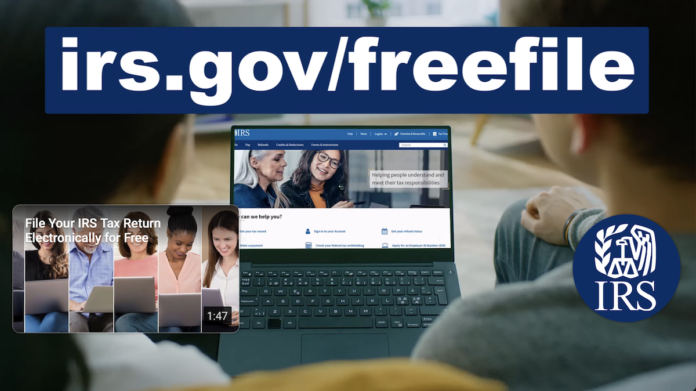
WASHINGTON (States Newsroom) — Many U.S. taxpayers in a dozen states, for the first time, can electronically file their federal returns directly to the Internal Revenue Service for free — but critics insist the new federal benefit is not needed and will even harm both users and states.
More than 50,000 taxpayers in Arizona, California, Florida, Massachusetts, Nevada, New Hampshire, New York, South Dakota, Tennessee, Texas, Washington and Wyoming have so far used the new online IRS Direct File program this tax season, according to the agency.
The free alternative to potentially costly private tax filing software rolled out in mid-March for the 2023 filing season. It is only available for those with W-2 income or simple credits and deductions, like the child tax credit or student loan interest.
The IRS estimates that 19 million taxpayers are eligible to use the new program in advance of the April 15 tax filing deadline.
CLICK HERE to access free IRS online filing
But opponents argue the government Direct File program is a waste of resources and will snag business from professional tax preparers. They say it will confuse taxpayers who are accustomed to automatically filing their federal and state returns together through private software.
Some states also claim it will cost them revenue and increase what they have to spend on collections from taxpayers who owe money to their states.
The IRS program is purposefully small for now. The agency said in a launch-day release that it’s following “best practices for launching a new technology platform by starting small, making sure it works and then building from there.”
The pilot program “is almost tailor-made for students and young people with simple tax situations,” IRS Commissioner Danny Werfel said in late March, encouraging people to visit the new directfile.irs.gov.
The White House is celebrating the launch as a win for President Joe Biden, who, in 2022, along with a Democratic-led Congress, authorized its funding to jumpstart the program as part of the Inflation Reduction Act.
The progressive Economic Security Project estimates that if the program scales up, it could eventually save the average taxpayer up to $160 annually in tax prep costs. Assuming broad public adoption, that could add up to Americans saving $11 billion a year in filing fees and time.
The organization also estimates low-income households could gain up to $12 billion in unclaimed federal tax credits and that the IRS would see a return on investment of more than $100 per federal dollar spent on the program due to less paperwork and fewer errors.
Roxy Caines, director of the Get It Back campaign, said Direct File could increase tax participation, particularly for low-income households.
“Having an accessible way to file taxes is really important because of the high cost of tax preparation as well as the arduous process. It’s often viewed as intimidating,” said Caines, who runs the financial literacy and tax credit advocacy campaign by the left-leaning Center on Budget and Policy Priorities.
‘Unnecessary and unconstitutional’
But not everyone is on board.
When Werfel appeared in February before the U.S. House Committee on Ways and Means, Republican Chair Jason Smith of Missouri described the program as a “scheme the American people didn’t ask for.”
In January, 13 Republican attorneys general sent a letter to Treasury Secretary Janet Yellen opposing “the unnecessary and unconstitutional efforts to empower the Internal Revenue Service with the expansive authority to prepare and file tax returns for all taxpayers.”
“American taxpayers do not want to invite the proverbial fox into the hen house,” wrote the officials, led by Montana Attorney General Austin Knudsen.
Attorneys general from Georgia, Idaho, Iowa, Louisiana, Missouri, Nebraska, South Carolina, Tennessee, Texas, Utah, Virginia and West Virginia co-signed it.
The officials wrote that a program for taxpayers to directly file with the IRS at no cost “needlessly threatens” the livelihoods of tax preparers.
“Every year, tens of millions of taxpayers file their taxes for free with help from existing programs or online software. Additionally, millions of Americans work with small businesses in our states to file their taxes at an affordable cost, including both independent tax preparation services and local accountants. They choose to do so because they want an advocate in their corner who will represent their interests against the IRS bureaucracy,” they wrote.
The IRS did not respond to a request for comment about the criticism.
Pete Sepp, president of the National Taxpayers Union, a fiscally conservative organization that advocates for simplifying the tax code, told States Newsroom the project has been “dramatically oversold” and is being piloted in “some very easy places,” including states that don’t collect their own income tax.
Money for the IRS would be better spent on improving customer service, he argues.
“Every single penny they can scrounge up from other places needs to be poured into that effort, right? Now, in our opinion, designing a portal for direct file that is underpowered and is competing with other services is just not a priority,” he said, referring to the 22-year “Free File” arrangement the IRS has had with select private companies.
So what about Free File?
Today, the vast majority of taxpayers file electronically, according to IRS data. Of the 160 million individual federal tax returns that the IRS processed in 2022, 150.6 million, or 94%, were e-filed. Of those, just under 3.3 million used what’s been criticized as an opaque and complicated electronic Free File program.
Free File dates back to the early 2000s, when the idea of e-filing was just budding, and the government had no such program in place.
President George W. Bush’s administration was exploring the possibility of a free direct file portal through the IRS website.
At the time, the agency was struggling after failed modernization efforts, and a public-private partnership with the burgeoning tax preparation software companies became an appealing option.
“The tax companies just said, ‘Well, we got a deal for you,’” recalls Nina Olson, who served as the National Taxpayer Advocate for the IRS from 2001 to 2019.
“And at that time, I was very suspect of the deal. I said at the time that they’re going to find themselves in 20 years, that you know, tax companies would pull out and you would have a patchwork of services available to people,” Olson, who now runs the nonprofit Center for Taxpayer Rights, said in an interview with States Newsroom.
What began in 2002 was an agreement between the IRS and a group of private tax prep software companies under the name Free File Alliance to offer free federal tax returns to those under a certain income threshold. In 2023, that annual earnings threshold was $79,000 or less.
Taxpayers who earn above that income threshold have the option to complete their federal returns for free, unguided, using fillable PDF tax forms.
The program, which is just over two decades old, has been scrutinized for not reaching the taxpayers who most need a free filing option and for not providing a better user experience.
A 2019 Treasury Inspector General for Tax Administration report described the program as “fraught with complexity and confusion.”
The inspector general found that in 2018 only 2.5 million of the 104 million taxpayers eligible for Free File actually used it.
About 34.5 million of those Free File-eligible taxpayers used one of the alliance companies’ commercial software options, and a likely 14 million of them paid to e-file their federal returns, the report found.
The low number of Free File users likely was because an estimated 9 million eligible taxpayers were unaware that they had to access the Free File software options via the IRS website.
Those who, for example, searched the web and found one of the IRS partner companies’ websites were “not guaranteed a free return filing,” and subsequently susceptible to advertising for potentially costly add-ons like “audit defense,” the report found.
Investigative reporting in 2019 by ProPublica revealed deliberate tactics to cloud the Free File program by Intuit, maker of TurboTax, one of the Free File Alliance’s largest partners.
Terms between the IRS and Free File Alliance initially included a commitment from the agency to not develop its own free online filing program. In exchange, the partner companies agreed to limit advertising and add-on solicitation on their free file web pages.
In 2019 the IRS dropped the prohibition on developing its own program. Limits on company marketing and solicitation for add-on products continued as part of the agreement — though Intuit would eventually have to pay for breaking its commitment.
H&R Block and Intuit, respectively, left the Free File Alliance in 2020 and 2021. Together, they served about 70% of eligible Free File taxpayers in 2019, according to a 2022 Government Accountability Office report that recommended that the IRS develop additional options for taxpayers to file for free.
Acknowledging the opposing viewpoints on whether the IRS should create, or could handle, its own program, the report concluded the agency “should work to manage the risk of taxpayers having fewer options to electronically file their federal taxes for free.”
In 2022, Intuit settled with attorneys general from across the U.S., agreeing to pay $141 million to Intuit TurboTax customers who ended up buying services that should have been free to them.
Today there are eight companies in the Free File Alliance, with differing income and tax situation criteria. All are listed on the IRS website.
Olson said she doesn’t view the IRS Direct File pilot as a competitor to the already existing Free File partnership. Rather, it’s “one more component of a robust tax online taxpayer account,” she said.
“This is what countries do around the world. We’re so far behind,” Olson said. “There’s a response to folks who say ‘The government doesn’t need to do this’ or ‘There’s no interest in this product.’ Regardless of whether there’s interest in the product, it’s a government obligation.”
Congressional mandate
Among the tens of billions of dollars Congress authorized for the IRS in the Inflation Reduction Act, $15 million was earmarked for exploring the possibility of an IRS-run direct federal tax filing system.
Specifically Congress mandated the agency to use the money to survey taxpayers’ wants and needs, obtain a third-party opinion, and report back to lawmakers on the costs to create and run such a program.
In its third-party review, the left-leaning think tank New America assessed that a successful IRS-run Direct File program “depends critically” on whether the agency prioritizes the project and begins with limited testing before building up.
The organization estimated that development, staffing, infrastructure and customer service for a scaled-up platform would cost the IRS annually anywhere from $22 million to $47 million if 1 million taxpayers use a Direct File program, and up to $126 million to $213 million in the event that 25 million taxpayers jump on board.
New America also recommended the IRS consider the importance of customer service, data privacy, and taxpayers’ habits of filing federal and state returns all on one platform — one of the main concerns of critics.
Ayushi Roy, deputy director of New America’s New Practice Lab, which led the review, told States Newsroom she’s been talking to taxpayers using the Direct File pilot and “broadly speaking, we’re finding that filers are really landing on either ‘Wow,’ or ‘it didn’t include me for now.’”
The group will conduct its own analysis of the IRS trial run, particularly focusing on the experience for Spanish-speaking filers.
As for taxpayer interest, the IRS found that 72% of survey respondents said they were “very interested” or “somewhat interested” in a free IRS-provided tool to prepare and file federal taxes.
The survey conducted in 2022 by MITRE, a nonprofit that runs federally funded research and development centers, also found that a top reason cited by 46% of those interested is that they would rather give their financial data to the IRS than to a third party.
An October 2023 report from the Treasury Inspector General for Tax Administration took issue with the design of the survey, warning that the interest level may be “overstated” because the survey did not include a “neutral” option for respondents to choose.
However, the largely Democrat- and progressive-aligned international polling firm GQR found in late January through early February that between 92% and 95% of taxpayers across political ideologies and income levels in Arizona, Florida, Georgia, New York, and Texas support a free online IRS filing service.
Several state governments already offer free public electronic filing for state income tax returns, including Alabama, Kansas, Kentucky and Pennsylvania, which offer the service regardless of income level. Some states, like California and Iowa, have income thresholds for free filing.
States bite back
Despite the adoption of free public filing in some states, 21 state auditors, comptrollers, and treasurers from 18 states sent a letter on March 25 to Yellen and Werfel expressing concern about the “serious harm” the IRS Direct File program will cause and urging them to “shut down” the service.
“Taxpayers are not the only parties who will suffer from Direct File. States will suffer, too. States will lose out on payments from Direct File taxpayers who owe state taxes but incorrectly assume that Direct File covers federal and state filings.
“States will then have to increase resources dedicated to collection efforts,” wrote the officials from Alaska, Florida, Idaho, Indiana, Iowa, Kansas, Kentucky, Louisiana, Mississippi, Nebraska, North Carolina, Ohio, Oklahoma, South Carolina, South Dakota, Utah, West Virginia, and Wyoming.
According to the Treasury Department, taxpayers using the IRS Direct File pilot in Arizona, California, Massachusetts, or New York are automatically directed to their state-supported tax filing websites. Those in Washington are sent to that state’s page to claim the Working Families Tax Credit.
The IRS could not provide a more specific figure of how many taxpayers have so far used Direct File, and its latest estimate stands at 50,000. Advocates say they expect to learn updated numbers as soon as a week after federal taxes are due on April 15.






